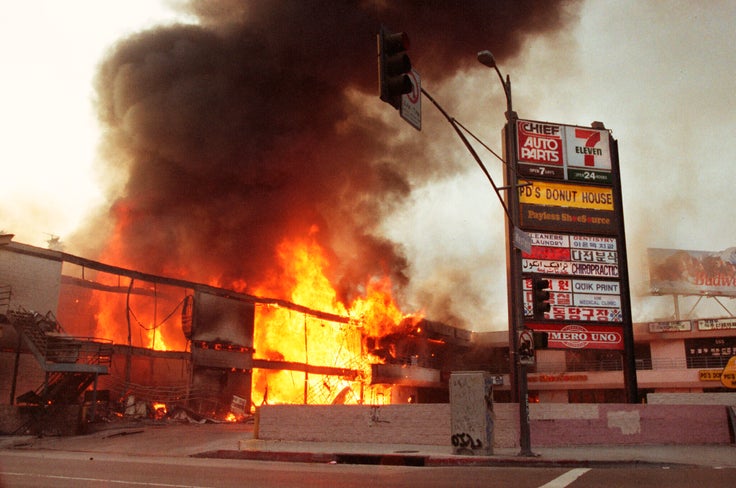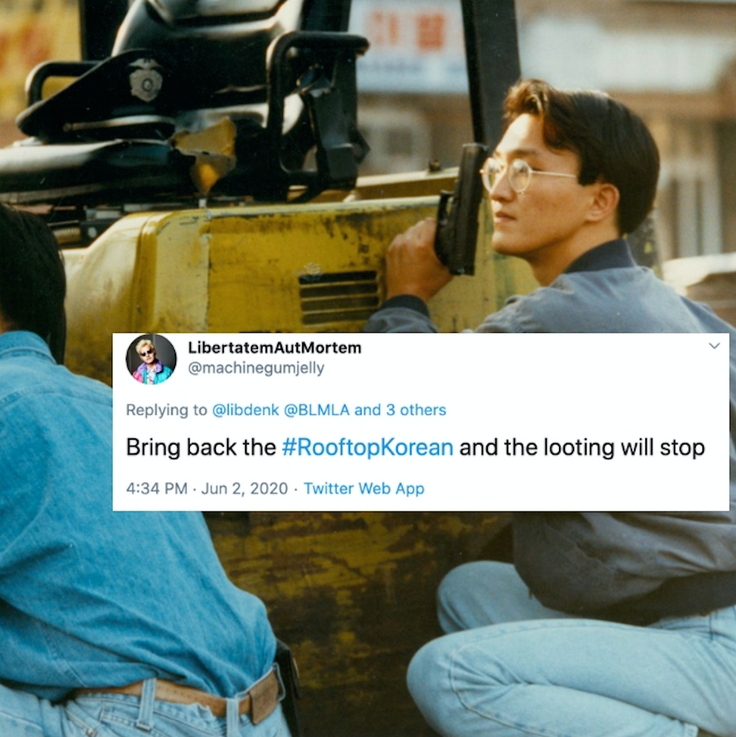In the wake of the anti-racism protests across the country, you may have seen some pro-gun family and friends share articles and memes about “rooftop Koreans.”
The dramatic pictures show Korean Americans taking up arms during the 1992 Los Angeles uprising, when riots and looting erupted after four white Los Angeles Police Department officers were acquitted in the brutal beating Black motorist Rodney King.
“Just like ’92. Don’t mess with the #RooftopKoreans,” one man tweeted.
“We should all be ready to do our duty as American citizens and, when duty calls, each of us should embrace our inner Rooftop Korean,” an article on Town Hall said, days after mostly peaceful protests against police brutality turned chaotic and resulted in looting in many cities across the U.S.
The right-to-bear-arms community has celebrated “roof Koreans” for a while ― they’re even depicted on stickers sold on sites like Etsy. But given that some gun-toting, Second Amendment groups have shown up to meet the Black Lives Matter protesters, now is definitely one of the more disturbing times in which they’ve been evoked.
“What we see here are white supremacists using ‘rooftop Koreans’ images and video to justify their own position,” said Edward T. Chang, a professor of ethnic studies at the University of California, Riverside, and the director of the Young Oak Kim Center for Korean American Studies at the university.
“This has potentially very damaging consequences to incite racial division and hatred between Korean Americans and other communities of color, particularly African American communities,” he said. “It speaks to a common divide and control strategy perpetuated by white supremacists.”
Chang said those who share the meme owe it to the Korean American business owners in the photos to do a deeper dive into the history of the 1992 Los Angeles uprising ― and what led them to take up arms to begin with.
Without any political clout and power in the city, Koreatown was unprotected and left to burn since it was not a priority for city politicians and the LAPD.
Edward T. Chang, a professor of ethnic studies at UC Riverside
The nearly weeklong unrest that occured in Los Angeles in the spring of 1992 left more than 60 people dead and more than 1,000 injured, and it caused an estimated $1 billion in damage, about half of which was sustained by Korean-owned businesses.
When the LAPD officers were acquitted, longstanding cultural clashes between Korean mom-and-pop store owners and their predominantly African American customers in the community spilled over.
It wasn’t surprising. Tensions had already reached a boiling point a year earlier, when Soon Ja Du, a Korean American liquor store owner, fatally shot Latasha Harlins, a 15-year-old Black girl, in South Los Angeles. Du claimed that Harlins tried to steal a bottle of orange juice. In the security camera footage, you see a scuffle between the two. Harlins eventually throws the juice on the counter and begins to walk away. As she does, Du shoots her in the head.
Du was given a light sentence for the killing ― probation and community service ― which outraged the Harlins family and the Black community.
Harlins’ name became a rallying cry during the 1992 uprising, and many believe it was a big reason that Korean Americans’ shops were targeted.
When the looting spread into Koreatown, the shop owners did indeed stand up to protect their businesses. As immigrants, they’d opened shops and liquor stores shortly after arriving in the U.S. in the late 1970s and early ’80s.
But they took up arms because the LAPD had, in the words of one K-Town shop owner, “left us to burn.”
Today, the Los Angeles uprising is known as “Sa-i-gu” in the Korean American community ― a phrase that literally means “April 29,” the day the violence began.
The unrest was a turning point for Korean Americans across the country, Chang said, and an absolute “wake-up call” to Koreans in Los Angeles to the indifference of the powers that be in the city.
“Without any political clout and power in the city, Koreatown was unprotected and left to burn since it was not a priority for city politicians and the LAPD,” Chang said. As rioting and looting spread, streets between Koreatown and wealthy white neighborhoods were blocked off by police, with official defense lines set up around largely white cities, including Beverly Hills and West Hollywood. Some Koreans said that emergency responders ignored their calls for help.
“It was containment,” Andy Yoo, a resident of K-Town who was 7 at the time, told CNN in 2017.

In the end, Chang said not a single person was shot and killed by the Korean shop owners — just warning shots to chase away potential looters and arsonists.
This is what makes the “rooftop Korean” meme frustrating to so many Korean Americans: Those who co-opt and meme-ify Korean shop owners speak of them reverentially. The police were overburdened, one man explained in a viral tweet, so the people of Koreatown “become peak American citizens by exercising their God given and constitutionally protected rights.”
But the Korean Americans that were literally on the rooftops in ’92 tell a different story.
“I truly thought I was a part of mainstream society,” Chang Lee, a gas station owner who immigrated with his family to the United States as a child, told CNN.
“Nothing in my life indicated I was a secondary citizen until the L.A. riots,” he said. “The LAPD powers that be decided to protect the ‘haves,’ and the Korean community did not have any political voice or power. They left us to burn.”
The “roof Korean” meme also forces Asian Americans to reckon with anti-Blackness in the community.
The fact that the meme has been shared or defended by some Asian Americans underscores an important truth: Racial minorities can be and often are racist against other racial minorities ― and in many Asian American families, anti-Blackness sentiment runs deep. (One of the Minneapolis police officers who stood by last month as Derek Chauvin pressed his knee down on George Floyd’s neck is Asian American, which has sparked a heated debate in the community about how Asians benefit from their proximity to whiteness.)
If we recognize that white Americans have, historically speaking, monopolized and excluded racial minorities from resources, we can see how easily Black people and Asians may feel as if they’re competing for the same pool of limited resources among themselves.
Racial resentment and distrust are bound to spring from that, as they did in Koreatown in 1992, when many Black patrons of Korean American businesses believed shop owners were funneling money out of the community and never putting anything back in.
When used by right-wing extremists, the “roof Korean” meme is meant to drive a wedge between Black and Korean communities, said Wendy Sung, an assistant professor of critical media studies at the University of Texas at Dallas.
“The ‘roof Korean or Asian’ can be historically situated within a pattern of touting Asian Americans as both a proxy for whiteness and as a racial weapon against Black claims of racial inequity,” she said.
Sung said it’s important to consider the “model minority” myth during conversations like this. The phrase was first coined in a 1966 New York Times article by sociologist William Petersen, who used it to describe Japanese Americans overcoming discrimination to find success, attributing it to hard work and family structure.
Asian American success was held up and used as a racial weapon against African American claims of systemic racism — essentially saying, if Asian Americans can do it without complaining, why can’t you?
Wendy Sung, assisant professor of critical media studies, the University of Texas at Dallas
“The important historical context here is the civil rights movement, when Black Americans were protesting for equal rights,” she said. “Asian American success was held up and used as a racial weapon against African American claims of systemic racism — essentially saying, if Asian Americans can do it without complaining, why can’t you?”
To see Asians glorified as the ultimate gun-toting citizen by the same far-right extremists who characterized Asians and Asian Americans “as vectors of disease merely weeks ago in this pandemic” is disconcerting, to say the least, Sung said.
Ranier Maningding, who runs the blog and Facebook community “Love Life of Asian Guy,” said it’s disheartening to see Asians in 2020 buying into that myth. When he saw the “rooftop Korean” meme circulating among some East Asian Americans, he was quick to call it out on his Facebook group.
“Asian Americans have a long, complicated and toxic relationship with white supremacy,” he told HuffPost. “We’ve always been made to feel like we’re two steps removed from whiteness. We’ve convinced ourselves into believing that we’re honorary whites because some of us come from middle-class or wealthy families, or we’ve bought into the myth of our own intellectual superiority.”
For many, it’s more than just a dislike of Black people, Maningding said, “it’s a fundamental belief that we’re made differently and thus destined for a life of academics and wealth, while the ‘others’ are built for poverty and crime.”
On Twitter last week, user Roscoe Von Rotten shared a Twitter thread that broke down the racial intricacies of the 1992 uprising while exploring anti-Blackness in Asian communities.
In the thread, Von Rotten reminded Asians who identify with alt-right beliefs that it wasn’t too long ago that East Asians, too, were seen as dangerous and subhuman by white supremacists. (As NBC News reports, the term “yellow peril” comes from the 1800s, when Chinese laborers were brought to the United States to replace emancipated Black communities as a cheap source of labor.)
“We’ve fallen so hard, hook, line and sinker, for the myth of the model minority,” she said.
Von Rotten is Korean American and was 5 at the time of the uprising. She knows firsthand how complicated Sa-i-gu is in Korean Americans’ collective memory. What happened during the destruction and looting is not something she and the elders in her family discuss with pride or braggadocio.
“They know who was up on the roof, and there is no ‘reliving the glory days,’ Von Rotten told HuffPost. “When looking at the photos from 1992, my parents and I agree that we’re proud of the community defending themselves. But we also agree that the pride does not extend to the fact that we had to do it at all.”
“We need to hold ourselves, and especially our communities, accountable in the ways we are complicit in supporting the white supremacist power structure and the anti-Black narrative in this country,” she added. “True change cannot happen unless we recognize and are held accountable for the roles we play and the words we speak.”
More than anything, Von Rotten said, the photos serve as a reminder that you can come to this country seeking a better life ― wanting the American dream and seemingly achieving it ― “but still be a second class citizen if you’re not rich and white.”
Comparing 1992 to 2020: What a difference almost three decades makes.
In the end, the rooftop photos are important ― not to be used as props for gun rights advocates and the alt-right ― but to show America’s complicated, unjust relationship with both minority groups.
And as protests over the deaths of Floyd, Breonna Taylor, Ahmaud Arbery and countless others continue, it’s heartening to see other images of Asian Americans ― including many Koreans ― standing with Black Americans.
A viral video from protests in downtown Los Angeles earlier this month shows community organizer Isabel Kang explaining why it’s essential for Asians to stand up as allies and confront their own internalized racism.
“To see that many Korean Americans haven’t woken up makes my heart break,” she said. “But those who know what it’s like to be oppressed get it right away.”
In Los Angeles’s Fairfax District, not far from Koreatown, Asian designer Bobby Kim, who goes by Bobby Hundreds, watched last month as fires were set near his streetwear store. Not long after, though, he hopped on Instagram and shared an impassioned message of solidarity with the protesters.
“When people ask why I’m not upset that my business is impacted or my neighborhood pillaged, I tell them that my disgust over injustices in this country eclipses any other temporary feeling,” he wrote. “Even if you bring the fire to my doorstep, I will stand in it with you.”
And in Koreatown now, shop owners seem less inclined to grab their guns and more inclined to stand with Black Lives Matter protesters.
Sam Yang co-hosts the martial arts and political theory podcast Southpaw and lives in Koreatown. Earlier this month, he shared some of the “Justice for George Floyd” and Black Lives Matter signs he’d seen hung up by Korean shop owners while taking a walk in his neighborhood with his toddler.
“I wanted to share what I wasn’t seeing ― armed Koreans, menacing people,” Yang told HuffPost. “So I sent out that tweet to say, ‘Here’s the stereotype in your mind, and here’s reality. Work on yourself.’
Yang said Asian Americans today are emboldened to speak out against things like the “rooftop Korean” meme because so many of their elders were essentially voiceless in 1992.
“The Korean American generation back in 1992 didn’t have social media,” he said. “No one wanted to speak with them or hear their story. If you can’t speak the language and you have no outlet, others speak for you.”
He said that those who share the meme are in essence “speaking for Korean Americans, telling us how to think and feel, co-opting our voice and our ability to tell our own narrative.”
Yang refuses to allow that to happen. Now is not the time for division, he said, it’s the time for minority groups to stand together.
“As Asians, we have our own work to do within our own communities, which starts with decolonizing ourselves from white supremacy and healing from its effects,” Yang said.
“But while we do that, we must support Black lives and we must protect Black bodies. We must be in solidarity with our Black and brown siblings,” he said. “Yellow Peril must support Black lives.”

